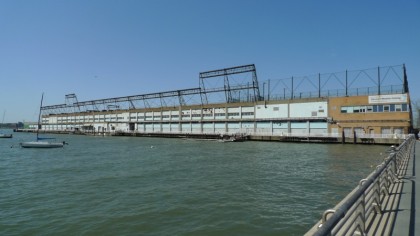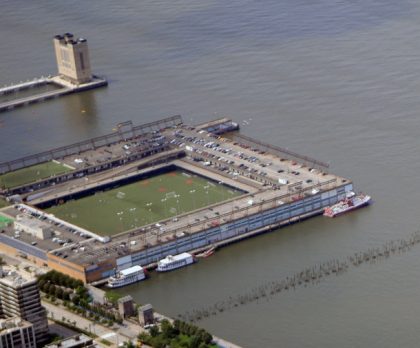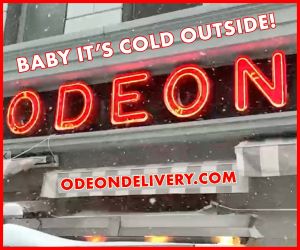Big hearing for Pier 40 tomorrow night
Starting with the full disclosure: I am a director of the Hudson River Park Trust, so I have a (non-financial, trust me on that!) interest in this issue. But the reason I was appointed by the borough president as a community rep is because I use this pier, my kids used this pier – a LOT – and I consider myself a downtown resident first, and an officer of the Trust – well, there’s a list and it’s on it somewhere.
You may have a full understanding of this already. If so, here’s your reminder that there’s an important hearing on changes to the Hudson River Park Act this Tuesday, May 28, 6 to 8p at 75 Morton. If not, take a stab at this post and read as much as you can take – it’s nothing that hasn’t been said before, but I felt the need to clarify. This pier is too important to downtown to misunderstand the issue and what’s at stake.
So. Pier 40 is its own rubik’s cube, but here’s the big-picture goal:
• Make it last (for decades, and arrest its current deterioration)
• Build the park and field space we are all desperate for (we are talking at least seven acres)
• Make rental income for the park (aiming for $12 million a year)
This is Pier 40’s beauty and burden: it’s a unique 15-acre lot in the middle of the Hudson River, in the heart of downtown, yet it is also a relic – a white elephant — and a development conundrum. The pier must make money for the park; that’s how the park works. It does not get your tax money. Instead, commercial parts of the park such as Chelsea Piers, ConEd, the Circle Line – and Pier 40 – pay for the open spaces, like Pier 25 and 26.
But here’s the sticking point: the pier cannot be redeveloped so that it makes enough money without changing the Hudson River Park Act, which excludes office use and a lot of other things that were determined in 1998 to be unappealing, long before anyone knew what it would take to care for the park. (The Pier 40 Champions formed by the local sports leagues proposed two 20-story residential towers a few years ago as an alternative and were castigated for it, so don’t bring that up. Here’s the Journal’s coverage of that in 2013.)
The Trust staff has decades of experience running the park and there are directors that know a lot more than I about development – Douglas Durst, local resident Jon Halpern, Jeff Kaplan – who also agree that this is what we need to move forward and get the pier rebuilt so it can last:
• Office tenants for the interior spaces (since they pay the most money per square foot and that will open up more park space)
• Up to a 99-year lease for the developer (this is the only way for developers to get bank loans to finance projects of this size)
• Space for the park to run its operations (offices, vehicle and plant storage, machinery, etc)
• An 88-foot height limit on the building, plus normal mechanicals
What this will get all of us (meaning the community and the users of the pier) is:
• A greater percentage of the pier set aside for park uses and field space (the current requirement is 50 percent; the proposal now is 60 percent)
• The potential for a greater connection to the river, the city and the rest of the park (especially since the building there now is no winner)
• A stable income for the park, since the piers north of 14th Street take most of that burden
• A developer who will shoulder the cost of building out the park space at the same time
This is how it will go down IF we can secure those changes in the act: The Trust will send out a request for proposals to developers; an environmental review process and a city land use process will be triggered; the Trust, elected officials, community will review the proposals and pick. What is key here is we are loosening up some current restrictions – the lease terms and the uses – so that we can see some real ingenuity and creativity come from the developers when the time comes. In my mind, the more restrictive we are, the less chance we have of actually getting something done on the pier – and getting field space for generations to come.
If you care about Pier 40 and this makes sense to you, come to the hearing and say so. If you disagree entirely, don’t come! (Only kidding – do you.) And as per always, email or comment with questions.
















Again, Warden Margaret Chin has proven to be a large disappointment in pulling out her support on this issue for the community. It seems that the only thing that Warden Chin is passionate about and willing to fight for is her jail. Oh yes, I forgot about her fight to take away the Elizabeth Street Garden from everyone in Soho. Anyone who voted for Warden Chin should be ashamed. We deserve better.
Lucie –
I concur, Margaret Chin is the worst. I received her “Highlights” pamphlet in the mail last night and her biggest concern is pop-up stores and she doesn’t even mention the monolith prison that will permanently disrupt and disfigure Chinatown and Tribeca.
You make no mention of the parking on the pier. How much revenue does the Trust make from parking? Personally, I’d be very disappointed to see parking space reduced. (Full disclosure, I park 2 vehicles there.)
It varies, but between $5 and 7 million. It’s definitely income, but not enough to pull its weight as the park gets bigger (for instance, soon we will be — very happily — paying for the maintenance of Pier 26). The northern parts of the park are doing all the work – namely in CB4’s district. The other factor is that Pier 40 itself needs maintenance because it is in such bad shape. Nearly every system in the place has failed or is failing. The electeds have all helped defray those costs, but it means they are diverting millions to keep the park open — fixing parts of the building (the roof, the stairs, the elevator) to keep it legal when the building itself is long past its prime. There have been years when the cost of Pier 40 made the income a wash. As for parking as a commercial use, I used to park there too (and now I use it as a daily parker – best deal in town!) but as much as I appreciated the good rate there, I’ve never thought parking was the optimal park tenant. Warehousing cars — and having those cars cross the bikeway/walkway — seems antithetical to a park. But there is no doubt the use has served HRP well over the years. It’s just no longer enough.
Where might the considerable number of cars that park at Pier 40 go? Development does not seem to be required to study this.
Pam refers to a proposal to build two residential buildings at Pier 40. I led that effort. The idea was to build on two buildings on the upland to free up the entire pier at a 15+ acre park. It was a completely transparent process presenting a very specific proposal. But the proposal was soundly defeated I learned from the wisdom of the community that I was wrong to propose it.
Hudson River Park is now on the cusp of becoming one of our city’s great parks. If HRPT succeeds in its goal of building three large office buildings in the park at Pier 40, Pier 57, and Pier 76 the park will be sadly diminished. This permanent loss could be avoided with an annual support for the park from the City and State of $10 million. Are we nuts?
HRPT and some of our elected officials (and Pam) tell us that Hudson River Park is required to obtain all its operations from commercial uses within the park. This isn’t true. The law allows “park/commercial” uses within the park and requires that all the revenue from such uses go to the Trust to fund park operations. It says the Trust shall fund park operations from such uses “to the extent practicable.” And it says the City and State may supplement funding for operations of the park.
When the Hudson River Park Act was passed it struck a compromise. It promised that the City and State would fund the development of the park and it allowed for limited commercial uses within the park. The compromise was necessary at the time because the vision of a park along the delipidated waterfront did not have strong support and the City and State were broke. There was no political will to take on the burden of funding a park (especially for the communities that had helped defeat Westway). The Trust and some of our elected officials now want to overturn this compromise even though the creation of the park has spurred the huge development of the west side that has contributed massively to government coffers and even though the importance of the park is now universally understood and supported.
The legislation change that is under consideration would allow development of a huge office building with up to 5000 workers who would have to cross the bikeway to get to and from work. It would allow the park uses at the pier to be controlled by the office developers. It does not promise an increase in the space of sports fields or community access to the water. Unlike the current courtyard fields that Pam’s children enjoyed, it does not provide for protection of ballfields from river winds. Worst, the legislation does not require ULURP which would provide for community involvement in the review of a development proposal. Instead it leaves the decisions entirely in the hands of the Trust board which is entirely controlled by the Governor and the Mayor.
Come to the hearing and help save the park from the intensity of commercial development that the Hudson River Park Act rightly prohibited.
Tobi says it will be a shame if we have offices at Piers 40, 57 and 76.
Well, Pier 57 is a landmark structure, and a very narrow pier, and office space was a perfect fit for that. In exchange we are getting a lot of public open space on the pier, rehearsal spaces for arts groups, tech education spaces, environmental education spaces, a new home for City Winery and a rooftop park (which will be used by Tribeca Film Festival each April for outdoor screenings). It was a tradeoff the community was willing to make and will generate significant income for the Park.
Pier 76 is now the NYC tow pound and an NYPD maintenance garage. Not exactly a wonderful park use. If we can change that and make Pier 76 primarily park space (and it is wide enough for fields) with an office building adjoining it, that is a vast improvement over the current use.
Of course, both Pier 57 and Pier 76 are in the area served by Community Board 4.
Pier 40 is the only major pier outside CB4 that is designated as an income producing pier for the park. But it seems like CB2 is unwilling to pay its fair share for a park that has been a wonderful addition to the neighborhood. Meanwhile, while we continue to park for the park, there are 8 areas of the park in CB4 that either have yet to be constructed or are due for renovation.
Lowell Kern
1st Vice Chair & Co-Chair, Waterfront, Parks & Environment
Manhattan Community Board 4
Anyone have access to the Minutes from the meeting?
It was a public hearing and I don’t think minutes were kept. It’s possible one of the electeds’ offices taped it, but I don’t think so.
I live quite close to Pier 40 and have for a number of years. I’ve never used it once. I was once aggressively shooed away from the entrance by a security guard when o my bike (apparently bikes aren’t allowed on the road in front, go figure), but that’s as close as I’ve gotten. I’m sure that if you park there and/or your kids play soccer there it’s an invaluable resource for you. But I just don’t see the Pier as something that serves the entire neighborhood or even city. Is breaking the HRP act worth it just to preserve some soccer fields and parking spaces? I can make a stronger argument for the jail than this proposal no matter how less appealing it is to have that nearby than more soccer fields.
With development and maintenance how long is Pier 40 expected to be out of commission?
More than 700 hundred children have signed up to play soccer with Downtown Soccer League this year. Never mind the kids who play on DUSC, Gotham, etc. In addition, Pier 40 provides space for kids to play baseball/softball/football, have summer day camps- honestly the uses are numerous. There are also plenty of adult football, rugby, soccer, baseball/softball leagues that use the field as well. Fields are an issue that needs to be looked at- even if you don’t have children using the fields or use them yourself- this is a community issue. Open spaces are good for the health of the community. Safe places for children (and adults) to play organized sports is healthy and good for a community (even if you or your children are not the ones using the field). And while I am sure there are pros and cons to every proposal- downtown does need the field space.
I’m sure it’s great for those children who use it but I don’t see it as reason enough to start allowing office space in Hudson River Park. Also think of it this way – if someone today proposed to build a new building jutting into the Hudson for soccer fields and offices it wouldn’t get past the first approval. Just wait the few years for Google to move in across the street and ask them to pay for it.
Totally agree with this statement. Recreational spaces are beneficial for the community.